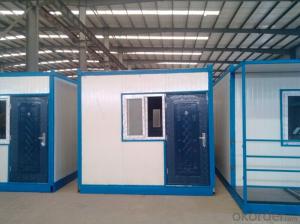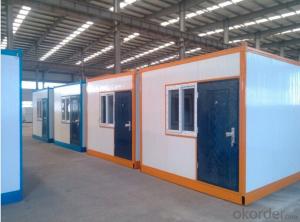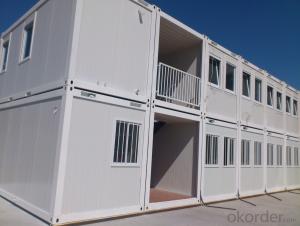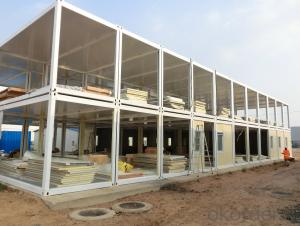Beijing Orient the constant integration activities chamber room
- Loading Port:
- Tianjin
- Payment Terms:
- TT OR LC
- Min Order Qty:
- 1 pc
- Supply Capability:
- 10000 pc/month
OKorder Service Pledge
OKorder Financial Service
You Might Also Like
Product introduction
The assembled series slope roof prefabricated houses
"Constant" brand series of slope roof assembled prefabricated houses is the company launched a new concept of environmental protection building economical activities, ordinary, standard and luxury type 3 kinds.According to customer demand, in a standard module for space combination, formed the skeleton system USES light steel structure, and to sandwich panels and PU tile forming palisade and roofing system.Realize the simple and beautiful, the construction fast, use safety, the standard of general overlay idea, make the overlay houses into an industrialized production, inventory, for repeated use of stereotypes housing products.
Sex can
Reliable structure: light steel system of flexible structure, safe and reliable, satisfies the requirement of building structure design codes.
Tear open outfit is convenient: housing can be repeatedly disassembling, repeated use.The installation process need only simple tools.Average per person per day to install 20-30 square meters, 6 people a team, 2 days to complete 3 k standard prefabricated houses 1 x 10 k.
Beautiful decoration: housing overall beautiful, bright color, texture soft, board face level off, have good adornment effect.
Flexible layout: doors and Windows can be installed in any position, interior partition can be set in any horizontal axis.The stairs set outside.
The structure of the building structure waterproof, waterproof design, does not need to do any other waterproof processing.
Long service life, light steel structure anticorrosion coating processing, normal service life can reach more than 10 years.
Environmental conservation: the reasonable design, easy tear open outfit, can be used many times cycle, low attrition rate, do not produce construction waste, the average annual cost is much lower than other materials of similar houses.
Using standardized components, a variety of specifications: building length and width are to K (1 K = 1820 mm) for the module.Transverse dimensions of mk + 160, the longitudinal size of nk + 160.
With the way
Are widely used in road, railway, construction and other field operation of temporary housing construction;Urban municipal, commercial and other temporary housing, such as: temporary office, conference room, headquarters, dormitory and temporary stores, temporary schools, temporary hospitals, temporary parking area, temporary exhibition hall, temporary filling stations, etc.
Assemble series flat roof prefabricated houses
"Constant" assembled series flat roof prefabricated housing is through making full use of their own strength of sandwich wall panel and roof panel, after pulling, bolts, self-tapping screw connection and finalize the design activities of housing system.Can be industrialized production, use, interior decoration, realize the inside and outside is beautiful, fast, safe construction overlay concept, tight sealing, heat insulation, waterproof, fireproof, moistureproof.
Aesthetically pleasing: housing overall modelling beautiful, inside and outside are color decorative plates, good appearance, design and colour collocation to coordinate.
Long use period: normal service life can reach more than 10 years.Convenient transportation, dismantling recycling, environmental savings.
With the way
Are widely used in road, railway, construction and other field operation of temporary housing construction;Urban municipal, commercial and other temporary housing.Such as: temporary office, conference room, headquarters, dormitory and temporary stores, temporary schools, temporary hospitals, temporary parking area, temporary exhibition hall, temporary maintenance, temporary transformer room, temporary filling stations, etc.Other temporary housing areas, such as military logistics temporary occupancy, rescue and relief temporary occupancy, sterile laboratories, isolation rooms, communication substation room.Scenic area of temporary use leisure villa, vacation homes, etc.
Products > > activity control box, the bathroom
Box is by utilizing sandwich wall panel and roof panel connection of their own strength, by screw, bolts, self-tapping screw, wall sandwich plate and the steel structure base housing system composed of roof plate connection.Quick construction, whole movable, especially suitable for municipal facilities and field construction site of the gatehouse, service, etc.
Toilet is mainly is made of light steel structure, caigang sandwich board maintenance material, to give expulsion-typely wastewater and circulating water storage (microbes) drainage way portable toilet.Can be very convenient to install, move, move, especially suitable for streets, sports venues, the use of tourist attractions.
Fence is made of steel structure column, double color sandwich steel or single color pressed steel by bolt connection and into.All of its components are composed of standard parts, the arbitrary assembly, short installation period, the effect is good, the color can be specially made according to the requirements.Repeatable tear open outfit, use, construction waste, beautiful appearance.
- Q:Can container houses be designed to have a rustic or industrial look?
- Yes, container houses can be designed to have a rustic or industrial look. With the right choice of materials, finishes, and architectural design, container houses can be transformed into aesthetically pleasing homes that embrace the rustic charm or industrial aesthetics. From incorporating reclaimed wood, exposed brickwork, and earthy color palettes for a rustic feel, to utilizing metal accents, concrete finishes, and minimalistic design for an industrial look, container houses offer flexibility and creativity in achieving various architectural styles.
- Q:Are container houses suitable for individuals who value privacy?
- Indeed, container houses are an ideal choice for individuals who prioritize privacy. The adaptability of container houses in terms of design and arrangement is one of their primary advantages. They can easily be customized to incorporate personal spaces like bedrooms, bathrooms, and even separate living areas. Furthermore, container houses can be strategically located in secluded areas, far from bustling environments, thereby further enhancing privacy. Moreover, container houses can be equipped with diverse privacy features, such as soundproofing, tinted windows, and additional insulation, to minimize external disruptions and maintain a sense of seclusion. In conclusion, container houses provide ample opportunities for individuals to fashion private and isolated areas within their dwellings.
- Q:Can container houses be designed with a community garden or park?
- Absolutely! It is definitely possible to design container houses with a community garden or park. As a matter of fact, the trend of incorporating green spaces and communal areas into container house communities is gaining popularity. By utilizing the rooftop and surrounding land, container houses can be designed to include gardens, parks, and other outdoor spaces that promote a sense of community and sustainable living. Container houses are incredibly versatile and can be easily modified to accommodate various outdoor amenities. For instance, residents can enjoy rooftop gardens or green roofs where they can grow vegetables, herbs, or flowers. These gardens not only enhance the visual appeal of container houses but also contribute to energy conservation, air quality improvement, and stormwater management. Moreover, container house communities can include shared parks or common areas where residents can gather, socialize, and unwind. These spaces can be designed with seating areas, playgrounds, picnic spots, or even fitness equipment, encouraging physical activities and fostering a sense of belonging among the residents. In addition to the numerous benefits of incorporating green spaces in container house communities, such as improved mental and physical well-being, reduced environmental impact, and increased social interactions, community gardens and parks also provide an opportunity for residents to engage in sustainable practices and learn about gardening and horticulture. All in all, container houses can indeed be designed with community gardens or parks, enabling residents to enjoy the advantages of nature, promote sustainable living, and cultivate a strong sense of community.
- Q:Are container houses suitable for guest houses?
- Yes, container houses can be suitable for guest houses. Container houses are becoming increasingly popular due to their affordability, sustainability, and versatility. These structures are made from repurposed shipping containers, which makes them a cost-effective option for guest accommodations. Container houses can be customized to fit the needs of a guest house. They can be designed to include all necessary amenities such as bedrooms, bathrooms, kitchens, and living areas. Additionally, they can be modified to provide a comfortable and functional living space for guests. Container houses are also portable, which means they can be easily relocated if needed. This flexibility allows homeowners to move the guest house to different areas of their property or even take it with them if they move to a new location. Furthermore, container houses are eco-friendly. By utilizing repurposed shipping containers, these structures contribute to reducing waste and promoting sustainability. In an era where environmental consciousness is growing, many guests appreciate staying in accommodations that prioritize sustainability. In conclusion, container houses can certainly be suitable for guest houses. They offer affordability, versatility, and sustainability, making them an attractive option for homeowners looking to create comfortable and functional guest accommodations.
- Q:Are container houses suitable for remote off-grid living?
- Yes, container houses are suitable for remote off-grid living. These houses are often designed to be self-sufficient and can be equipped with solar panels, rainwater harvesting systems, and composting toilets. Additionally, their modular nature makes them easy to transport and assemble in remote locations.
- Q:Are container houses suitable for temporary or mobile living?
- Container houses are a great option for temporary or mobile living since they are specifically constructed for easy transport and setup in various locations. This makes them perfect for individuals who frequently relocate or require temporary housing. Constructed using sturdy materials, container houses are capable of withstanding transportation and harsh weather conditions, ensuring a secure and comfortable living environment. Moreover, container houses can be personalized and altered to cater to specific requirements and preferences, thus providing flexibility for temporary or mobile living arrangements. The space-efficient design of container houses also enables efficient utilization of space, making them suitable for compact living areas or temporary housing necessities. All in all, container houses present a practical and convenient solution for those in search of temporary or mobile living alternatives.
- Q:Can container houses be built with a separate guest house or studio?
- Yes, container houses can definitely be built with a separate guest house or studio. Container houses are highly customizable and can be designed to fit various needs and preferences. By utilizing additional shipping containers or modifying the existing structure, it is possible to create separate spaces for guests or a studio within the container house. This allows for versatility and the ability to accommodate different living arrangements or creative spaces.
- Q:Can container houses be designed with a traditional or rustic style?
- Yes, container houses can be designed with a traditional or rustic style. By using various exterior finishes, such as wood or stone cladding, and adding architectural elements like gable roofs, porches, or window shutters, container houses can be transformed to have a traditional or rustic aesthetic. Interior design elements, such as using reclaimed materials, warm color schemes, and rustic furnishings, can further enhance the traditional or rustic style of a container house.
- Q:Are container houses customizable in terms of layout?
- Container houses offer a high level of customization when it comes to their layout. Utilizing shipping containers as a construction material provides immense versatility and adaptability. It is effortless to modify and reorganize these containers to achieve various layouts, opening up a world of design possibilities. By removing or relocating walls, container houses can be transformed into more expansive, open spaces or smaller, more intimate rooms, depending on the desired arrangement. Moreover, the addition or relocation of windows and doors allows for the maximization of natural light and the optimization of space flow. By enlisting the expertise of skilled architects and designers, container houses can be tailored to fulfill specific needs and preferences, making them an increasingly popular choice for those seeking a unique and personalized living environment.
- Q:Can container houses be built off-grid?
- Indeed, it is possible to construct container houses that operate independently from public utilities, a concept known as off-grid living. Container houses can be customized and engineered to adhere to the criteria of off-grid living. To achieve an off-grid container house, a range of systems can be implemented. Installation of solar panels on the roof enables the generation of electricity, which can then be stored in batteries for use during cloudy days or at night. Additionally, a rainwater harvesting system can be established to collect and store rainwater for daily use, thereby reducing reliance on municipal water supplies. These container houses can also integrate composting toilets or septic tanks to manage waste, eliminating the need for a connection to a sewage system. Greywater recycling systems can be employed to treat and recycle wastewater from sinks, showers, and washing machines, effectively minimizing water consumption. Moreover, optimization of insulation and ventilation is crucial for maintaining a regulated interior temperature, thereby reducing the necessity for heating or cooling systems. This can be achieved through the utilization of energy-efficient windows, insulation materials, and natural ventilation techniques. Container houses possess adaptability and can be constructed in remote locations, making them ideally suited for off-grid living. With appropriate modifications and the implementation of requisite systems, container houses can offer a sustainable and self-sufficient living solution.
1. Manufacturer Overview |
|
|---|---|
| Location | |
| Year Established | |
| Annual Output Value | |
| Main Markets | |
| Company Certifications | |
2. Manufacturer Certificates |
|
|---|---|
| a) Certification Name | |
| Range | |
| Reference | |
| Validity Period | |
3. Manufacturer Capability |
|
|---|---|
| a)Trade Capacity | |
| Nearest Port | |
| Export Percentage | |
| No.of Employees in Trade Department | |
| Language Spoken: | |
| b)Factory Information | |
| Factory Size: | |
| No. of Production Lines | |
| Contract Manufacturing | |
| Product Price Range | |
Send your message to us
Beijing Orient the constant integration activities chamber room
- Loading Port:
- Tianjin
- Payment Terms:
- TT OR LC
- Min Order Qty:
- 1 pc
- Supply Capability:
- 10000 pc/month
OKorder Service Pledge
OKorder Financial Service
Similar products
New products
Hot products
Related keywords


























